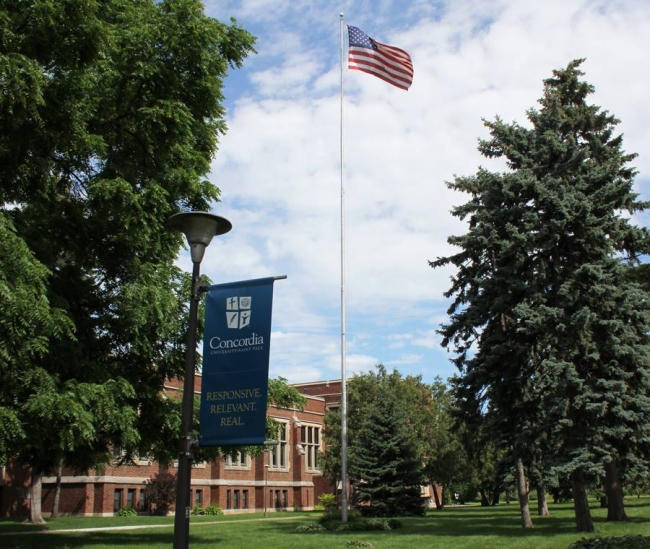You have /5 articles left.
Sign up for a free account or log in.

Concordia University, St. Paul
MINNEAPOLIS -- As private college sticker prices and tuition discount rates edged ever higher in recent years, there has been much hand-wringing and debate over whether the cost of college has reached a breaking point.
Serious discussions have also taken place about an aggressive strategy some institutions have used to distance themselves from the high-tuition, high-discount strategy: the tuition reset.
Tuition resets were under the microscope Tuesday during a session at the National Association of College and University Business Officers annual meeting. And the debate over the strategy could be easily found at other times during the several-day meeting as well, in other sessions as well as discussions with tuition pricing consultants.
Tuesday's session highlighted two institutions that have put in place tuition resets in recent years. Concordia University St. Paul in Minnesota cut its tuition and fees sticker price by a third, from $29,700 to $19,700, in the fall of 2013 for all of its traditional undergraduate students. Utica College in upstate New York slashed its sticker price by 42 percent in the fall of 2016 for on-campus undergraduates, dropping tuition and fees from $34,466 to $19,996 before room and board.
Leaders from both institutions reported Tuesday that the changes were successful. Concordia has seen student retention rise, student loan debt fall and undergraduate enrollment grow since its reset. Utica's enrollment and applications rose after the reset as well. Both institutions reported increased net tuition revenue and, of course, sharply lower tuition discount rates.
But the Tuesday presentation was not an endorsement of tuition resets at all private universities.
“Most of the schools that have cut it have not put in the time to do the research to see if it will actually work for them,” said Laura Casamento, president of Utica College.
Casamento has studied tuition resets. They were the subject of her dissertation. She examined 28 institutions that have tried tuition resets over the last two decades and believes a lack of planning often led to poor strategies. That, she said, is why many college leaders and some consultants are now wary of tuition resets.
Of course, there are many reasons to be cautious. Panelists agreed that the strategy can only be put in place after significant planning, and that institutions need to have a strong brand and strong market position to succeed with it. Cutting tuition at an institution with a weak market position can be perceived as the cheap getting cheaper.
Details of how the plan is put in place are important, too. It has to be communicated effectively and at the right time. Colleges don't want to announce a tuition reset for 2018 in August 2017, when it is likely to drive students who were planning to enroll to instead defer until next year. Nor do they want to announce one too late in the recruitment cycle, when they will not get the full effects of the strategy and attention it can generate.
A reset cannot be the only way a college markets itself to students, Casamento added. Utica College went through several steps of research and branding before putting in place its tuition reset. Freshman enrollment was rising even before the reset was announced, likely thanks to a branding campaign.
Freshman enrollment went from under 500 in 2014 to just under 700 in 2016, said Jeffery Gates, Utica College's senior vice president for student life and enrollment management. The college dropped its freshman enrollment goal to 625 this year because it has run out of capacity -- it will have 110 students living in a hotel this fall, which brings added costs and does not help the bottom line.
Utica College's freshman tuition discount rate fell from more than 60 percent in 2015 to just over 30 percent in 2016. It is projected for a bit over 20 percent in 2017.
Freshman yield rate had ticked up between 2015 and 2016, but it dropped this year. Gates attributed that to New York State's new free tuition program for public colleges, which lawmakers and the state's governor agreed to create in April for the upcoming fall.
“Our activity at that point just stopped,” Gates said. “Things were looking great until that announcement, then things stopped. So we accepted more students and now we are starting to see some additional deposits come in late this summer.”
That highlights an important question about resetting tuition -- what other colleges and universities is an institution competing with for students? Both Utica College and Concordia in St. Paul were competing in large part with public institutions, which tend to have lower sticker prices and lower tuition discount rates.
“Part of the price point there is you are now closer to the publics,” Gates said. “So for us that was where we were also taking some students from.”
Families can understand paying $2,000 or $3,000 more for a private education and the smaller class sizes it brings, Gates said. But they might be scared away by drastically higher sticker prices.
That's an important point to consider, especially since tuition resets are sometimes cast as a way to attract first-generation students who are not attending college at all because of high sticker prices.
Concordia University St. Paul reports net tuition revenue from its traditional undergraduate program rising since the reset. Its net tuition revenue was $12.9 million in 2012-13, before the reset, and $14.1 million in 2015-16. The university's discount rate fell from 48 percent in 2012-13 to 33 percent in 2016-17.
Traditional undergraduate enrollment rose from 1,211 in the fall of 2012 to 1,456 in the fall of 2016. Interestingly, the university reports enrolling more students from well-off families. The number of freshmen it enrolled judged to have no financial need doubled between 2012 and 2016, although it remains a small portion of overall enrollment -- the university reports 24 freshmen judged to have no need enrolled in the fall of 2016, when the freshman class numbered 239. The university also reported an increase in the number of Pell-eligible first-year students enrolled after the tuition reset, although that number has been trending down.
One challenge to resetting tuition is selling trustees and alumni on the idea, said Eric LaMott, the chief operating officer at Concordia in St. Paul. Some get caught up on the idea that an institution is a school worthy of a $50,000 sticker price, he said.
“I call it the testosterone war,” he said. “Our job as leaders of higher ed is to help carry our institutions into tomorrow and not live in yesterday.”
Some trends would seem to point toward a lower tuition, lower aid model, at least for some students. Families are increasingly shopping for price when it comes to college, said Carole Arwidson, vice president and director of market research for the Lawlor Group, a higher ed marketing firm. They are asking about a return on their investment, and they are wary of student loans.
Half of all undergraduate students attend a college with a tuition and fee sticker price of less than $12,000 per year, she said. At the same time, discount rates are at an all-time high, and institutions are struggling to increase net revenue, even if they raise sticker prices.
“This is sobering,” Arwidson said.
Yet many remain unconvinced that tuition resets are viable for most institutions. A model with high sticker prices allows institutions to bring in more revenue from wealthy students and use some of that revenue to buy down the tuition of students from lower-income backgrounds -- or other students admissions officers find desirable who otherwise would choose to go elsewhere. In many cases, some strategists argue, that's a better way for colleges and universities to build the classes they want and maximize their revenue.
The wrong strategy at the wrong institution can hit applications, enrollment and net revenue. In a Sunday session, Craig Goebel, a principal at Art and Science Group, said his firm had tested a tuition reset for a private institution that had been discounting heavily. Cutting tuition and fees by 54 percent and not offering aid would lead to an enrollment drop of over 50 percent and a drop in applications of over 40 percent, he said.
“If you compound that together, it's a closing of the doors,” Goebel said. “I present this not in a sense to say, ‘Don't do it, we don't recommend it,’ but more as a cautionary tale.”
Art and Science has studied various institutions and found the best-case scenarios among them for a tuition reset are neutral impacts on net revenue. Goebel's session also explained that Providence College boosted its bottom line by increasing its tuition and aid in the years after the financial crisis.
Of course, there are numerous ways to implement a tuition reset. Institutions can still discount their tuition after a reset -- both Concordia and Utica College continued to offer institutional aid.
If a reset has a chance of working, it needs to be studied in depth, said John Lawlor, founder of the Lawlor Group, who led the Tuesday session.
“These are strategic initiatives -- they're not promotional gimmicks,” he said.
The Lawlor Group has received five inquiries in the past two months from institutions seeking to do tuition resets. They wanted to put resets in place in August or September of this year, Lawlor said.
“We said, ‘Thank you for your interest,’” he said. “That’s a promotional gimmick. It’s not strategically sound, and we don’t want any part of that.”




